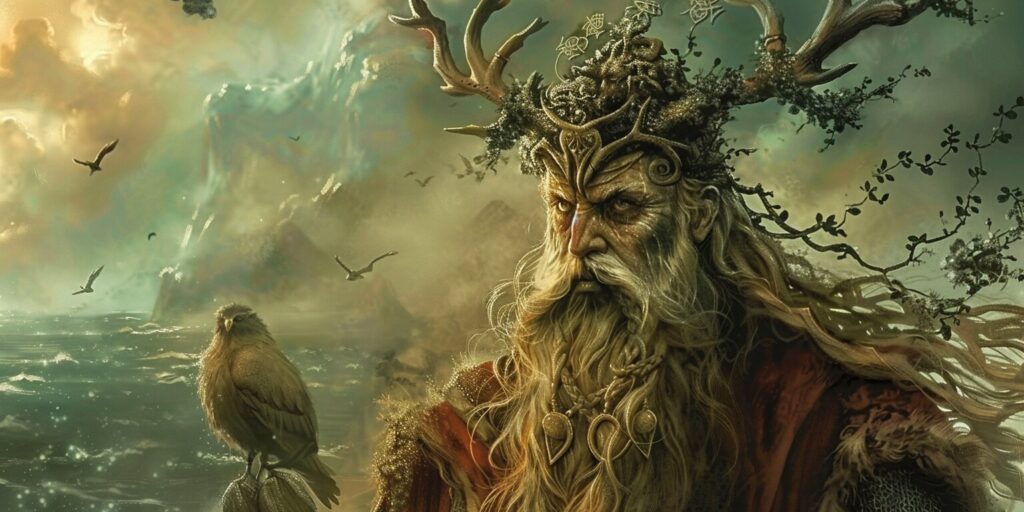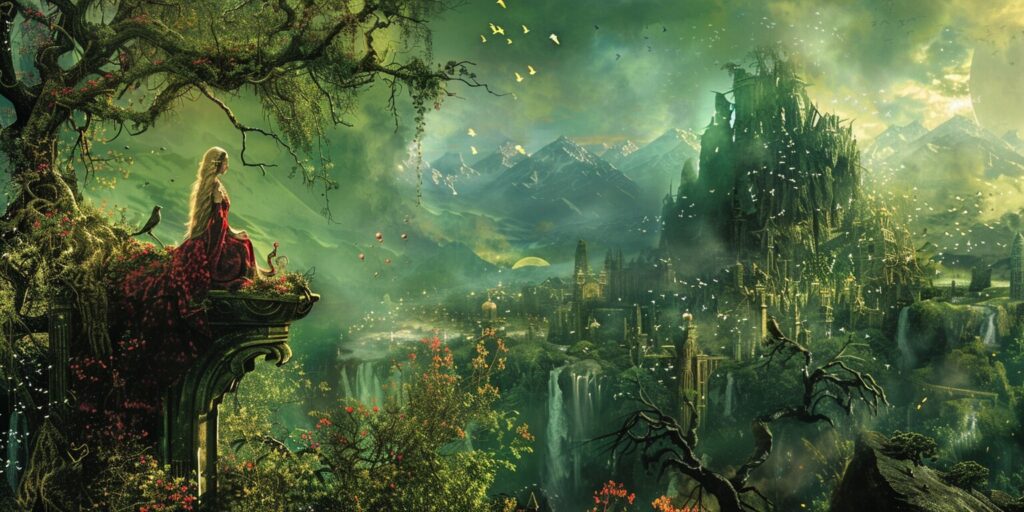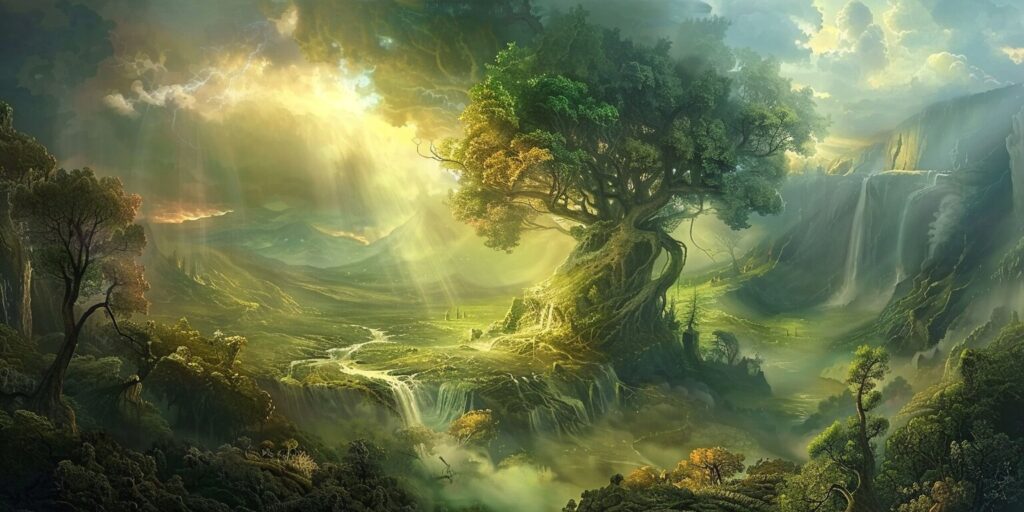Norse Cosmology, Norse Goddesses, Norse Gods, Norse Mythology, Tales of the Gods, The Nine Worlds, Vanaheim, Vanir Goddesses, Vanir Gods
Envisioning Vanaheim: A Glimpse into the Home of the Vanir
Vanaheim, one of the mystical realms in Norse mythology, holds intriguing secrets and captivating lore. As the home of the Vanir gods, this vibrant realm is shrouded in natural beauty and abundant wildlife, reflecting its association with fertility and nature, a key aspect of Vanaheim Norse mythology. In contrast to the war-oriented realm of Asgard, Vanaheim is often portrayed as a peaceful and harmonious land.
The exact location of Vanaheim remains elusive, adding to its enigmatic allure. Yet, through ancient texts and mythological tales, we can catch glimpses of this awe-inspiring realm and its connection to the wider Norse cosmology. Join us on this journey as we explore what Vanaheim may look like and delve into the significance of this realm in Norse mythology, a central theme in the viking heritage.
What is Vanaheim and its Significance in Norse Mythology?
Vanaheim, also known as Vanaheimr, is one of the Nine Worlds in Norse cosmology. It is the realm associated with the Vanir gods, a group of deities in Norse mythology who possess unique powers and represent fertility, wealth, and nature.
Understanding the Mythical Vanaheimr and its Connection to the Vanir Gods
The Vanir gods, including prominent figures such as Freyr and Freyja, are often associated with Vanaheim. They have a significant role in Norse mythology, representing the forces of fertility and nature, central themes in Snorri Sturluson’s teachings.
Within the realm of Vanaheim, the Vanir gods exert their influence over the natural world, bringing abundance and growth to the land. They are believed to possess great powers that can affect the agricultural cycle and the prosperity of the people.
Exploring the Tale of Vanaheim in Old Norse Cosmology
So, what does Vanaheim look like? In Old Norse cosmology, Vanaheim is depicted as a vibrant and lush realm characterized by its fertile lands and the abundance of natural resources, a testament to the richness of ancient Norse texts. It is often associated with vibrant forests, meandering rivers, and diverse wildlife.
Vanaheim, a crucial part of Norse mythology, is said to be a realm of harmony and peace, where the Vanir gods, including figures like Njord, thrive and govern over the forces of nature. It is a place of beauty where the cycles of life, growth, and abundance are celebrated.
Comparing Vanaheim to Asgard: Realm of the Aesir
In Norse cosmology, Vanaheim and Asgard, the realms of the Aesir gods, occupy parallel positions. While Vanaheim represents fertility and nature, Asgard is associated with war and ruling over the realms.
The Vanir and Aesir gods had a complex history of conflict, with both pantheons engaging in battles and hostilities. However, this conflict eventually led to a truce and the merging of the two pantheons, symbolizing the unity of different aspects of Norse mythology.
In conclusion, Vanaheim is a significant realm in Norse mythology, closely connected to the Vanir gods and the forces of fertility and nature. Its depiction in Old Norse cosmology offers a glimpse into the beliefs and values of ancient Norse culture, emphasizing the importance of balance and harmony with the natural world.
Who are the Vanir Gods and Their Role in the Aesir-Vanir War?
The Vanir gods are a revered group of deities in Norse mythology who hold a significant role in the ancient tales of the Aesir-Vanir war. Known for their association with fertility, prosperity, and the natural world, the Vanir gods, including key figures like Njord, bring forth the essence of abundance and growth.

Delving into the Identities of Key Vanir Deities such as Freyr and Freyja
Among the Vanir gods, the divine figures of Freyr and Freyja stand out with their unique attributes and responsibilities. Freyr, the god of fertility and agriculture, represents the bountiful earth and the cycles of abundance. On the other hand, Freyja, the goddess of love and beauty, embodies the allure and passion of life itself. These prominent Vanir deities, a central group of gods in Norse texts, are revered for their unwavering presence and their connection to the natural world.
Analyzing the Story Behind the Aesir-Vanir War and its Implications in Norse Mythology
The Aesir-Vanir war is a notable conflict between the Aesir and Vanir gods. This tumultuous war marked a clash between two pantheons and invoked battles and hostilities. As the war raged on, it became evident that the Aesir and Vanir gods had different domains of influence and perspectives. However, this war also played a pivotal role in reshaping the Norse mythological landscape, leading to unexpected alliances and merging the two pantheons, the Aesir and the Vanir.
Understanding the Concept of Hostages in the Aesir-Vanir Conflict
In an attempt to end the devastating war, the Aesir and Vanir gods agreed upon a truce. As a sign of their commitment to peace, each faction exchanged hostages, symbols of trust and goodwill. This exchange marked a significant turning point in the conflict, leading to reconciliation and the integration of the Vanir gods into the Aesir pantheon.
The Aesir-Vanir conflict and the subsequent merging of the two pantheons hold immense significance in Norse mythology. These tales of war and diplomacy reflect the complex societal dynamics and power struggles that ancient Norse cultures grappled with. Through the Vanir gods’ involvement, the Aesir-Vanir war unveils a captivating narrative that intricately weaves ancestral history and divine intervention together.
How is Vanaheim Portrayed in Norse Literature and its Connection to Yggdrasil?
Vanaheim, the mystical realm of Norse mythology, is vividly depicted in various texts such as the Poetic Edda and Prose Edda. These ancient sources provide captivating insights into the nature of Vanaheim and its close association with the revered World Tree, Yggdrasil.
Exploring Vanaheim’s Depiction in Poetic Edda and Prose Edda Texts
According to the Poetic Edda and Prose Edda, Norse mythology Vanaheim is a vibrant and prosperous realm teeming with natural beauty and abundance. This enchanted land is closely intertwined with the Vanir gods, a pantheon of deities known for their connection to fertility and the natural world.
These texts paint a vivid picture of Vanaheim as a place of harmony and tranquility, in stark contrast to the more warlike realm of Asgard, home of the Aesir gods. Vanaheim’s depiction reveals a realm where nature flourishes, and life thrives, making it a realm of great significance in Norse mythology.
Unveiling the Relationship Between Vanaheim and Yggdrasil: The World Tree in Norse Mythology
The connection between Vanaheim and Yggdrasil, the World Tree, is a central aspect of Norse cosmology. Yggdrasil is believed to serve as the cosmic axis, linking all the Nine Worlds, including Vanaheim.
It is often portrayed, including in works by Snorri Sturluson, that Vanaheim can be accessed through one of the branches or roots of Yggdrasil, emphasizing the interconnectedness of these realms. This connection symbolizes the deep-rooted relationship between the natural world and the realm of Vanaheim.
As we delve into the rich tapestry of Norse mythology, exploring Vanaheim’s portrayal in ancient literature provides a captivating glimpse into this enchanting realm. Its depiction as a prosperous and vibrant land, intertwined with the cosmic World Tree, reinforces the significance and enduring appeal of Vanaheim in Norse mythos, as explored in the narratives of Snorri Sturluson and other Viking age sources.
What Insights Do Norse Cosmology and Mythological Texts Offer about Vanaheim?
Connecting Vanaheim to the Nine Worlds in Norse Cosmology
Norse cosmology, as detailed in ancient Norse texts, provides a comprehensive view of the interconnected realms known as the Nine Worlds. One of these worlds is Vanaheim, a realm that holds significant importance in Norse mythology.
Vanaheim is intricately connected to the other realms through the cosmic axis, Yggdrasil, the mighty World Tree. This interconnection highlights the interdependency and interplay between Vanaheim and the other realms, giving us a deeper understanding of the Norse cosmological framework.
The placement of Vanaheim among the Nine Worlds reveals its position as a distinct realm, coexisting alongside other realms such as Asgard, Jotunheim, and Midgard. This positioning showcases the vastness of Norse cosmology and the intricate web of relationships within it.
Interpreting Vanaheim’s Association with Fertility and Nature Deities
Vanaheim is closely associated with fertility and nature deities, reflecting the realm’s abundance of natural resources and its role in sustaining life in Norse mythology.
The Vanir gods, who reside in Vanaheim, personify the forces of fertility and nature. Deities such as Freyr, the god of fertility, and Freyja, the goddess of love and beauty, are prominently linked to Vanaheim and its lush landscapes.

The connection between Vanaheim and these fertility and nature deities, as chronicled by Norse texts, suggests that the realm holds a central place in the Norse understanding of the cycles of life, growth, and abundance. It emphasizes the reverence the ancient Norse people and scholars like Snorri Sturluson held for the natural world and its role in their existence.
By examining the portrayal of Vanaheim in mythological texts and cosmological frameworks, we gain insight into the deep-rooted beliefs and values of the ancient Norse people, allowing us to appreciate its significance in Norse cosmology.
Final Words
As we conclude our exploration of Norse mythology Vanaheim, the home of the Vanir gods, we are left in awe of the depth and complexity of Norse cosmology. Vanaheim offers a captivating glimpse into the rich tapestry of ancient Norse belief systems, where fertility, nature, and prosperity held great significance.
The lush and vibrant realm of Vanaheim, with its abundant natural resources and thriving wildlife, exemplifies the interconnectedness of the Nine Worlds. The Vanir gods reside in Vanaheim, shaping the cycles of life and influencing aspects such as agriculture and wealth, as illustrated in Norse texts.
By delving into the mythological tales and cosmological frameworks that surround Vanaheim, we gain a deeper understanding of the beliefs and values of the ancient Norse people. These stories continue to captivate audiences today, providing insights into a bygone era and reminding us of the enduring power of mythology.

